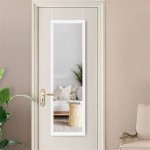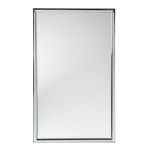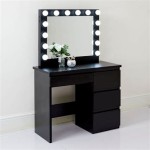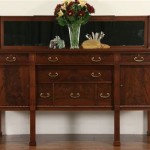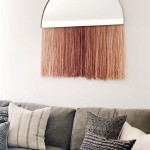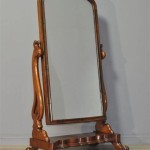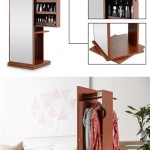What to Use to Hang a Full-Length Mirror
Full-length mirrors are a versatile and essential addition to any home, offering the ability to check your outfit, admire a new hairstyle, or simply brighten up a room. However, hanging a full-length mirror securely can be a challenge, especially if you're dealing with heavy frames or want to avoid damaging your walls. Fortunately, there are various methods and tools available to ensure a safe and stylish installation.
Choosing the Right Hanging Method
The best way to hang a full-length mirror depends on several factors, including the mirror's weight, the wall material, and your desired aesthetic. Here are some of the most common and reliable methods:
1. D-Rings and Wire
D-rings and wire are a classic and versatile choice, suitable for mirrors of various sizes and weights. D-rings are typically attached to the back of the mirror frame, and a wire is threaded through them. The wire is then mounted to the wall using hooks or nails. This method allows for a subtle and elegant hanging style, as the wire can be adjusted for height and alignment.
2. Hanging Hooks
Hanging hooks, often referred to as "picture hanging hooks," are designed to securely hold lightweight to medium-weight items, including mirrors. These hooks come in various sizes and weight capacities, so it's crucial to choose ones that can support the mirror's weight. They are installed directly into the wall using screws or nails, making them a quick and straightforward solution.
3. Wall-Mounted Mirror Hangers
Wall-mounted mirror hangers offer a more robust and specialized option for larger and heavier mirrors. These hangers are designed specifically for mirrors, providing ample support and stability. They typically come with adjustable arms or brackets that can be customized to the mirror's shape and size. The hangers are installed to the wall using screws or anchors, providing a secure and lasting hold.
4. Adhesive Strips
Adhesive strips offer a convenient and damage-free option for hanging lightweight mirrors. However, it's important to note that these strips are not suitable for heavy mirrors or those located in areas with high humidity or moisture. They are ideal for temporary or decorative installations where a permanent solution is not desired.
Understanding Wall Materials
The type of wall you're working with is crucial in determining the appropriate hanging method. Different wall materials require different tools and techniques for safe and secure installation.
1. Drywall
Drywall is a common wall material in many homes. It requires specialized anchors or screws for secure hanging. Drywall anchors are designed to expand within the wall cavity, providing a robust hold even for heavier mirrors.
2. Plaster
Plaster walls are often found in older homes. They are generally more rigid than drywall but require careful consideration when hanging mirrors. Using appropriate-sized nails or screws and avoiding excessive force are essential when working with plaster walls.
3. Concrete
Concrete walls are durable and sturdy but can be challenging to work with. Hanging a mirror on a concrete wall requires specialized tools and techniques. Heavy-duty anchors or masonry drill bits are necessary to create secure points for hanging.
Tips for Hanging a Full-Length Mirror
Hanging a full-length mirror safely and securely requires careful planning and execution. Here are some helpful tips to ensure a successful installation:
1. Measure and Mark
Before drilling or hammering, accurately measure the desired location for your mirror and mark the wall with a pencil. Ensure the marked location is level and aligns with any surrounding furniture or décor.
2. Use a Level
A level is essential for achieving a perfectly straight and symmetrical hang. Use a level to check the marked location and adjust it as needed before proceeding with installation.
3. Test the Weight Capacity
Crucially, always test the weight capacity of your chosen hanging method and make sure it's sufficient for your mirror's weight. It’s better to err on the side of caution and select a method designed for heavier items.
4. Use a Stud Finder
For added security, use a stud finder to locate wall studs when hanging heavy mirrors. Stud finders help locate the structural supports within the wall, providing the most stable points for installation.
5. Seek Professional Help
If you're unsure about any aspect of the installation process or are dealing with a particularly heavy or large mirror, it's always advisable to seek professional help. A qualified tradesperson can ensure a safe and proficient installation.
Remember, hanging a full-length mirror is a straightforward process with the right tools, knowledge, and a bit of care. By carefully considering these tips and guidelines, you can confidently create an elegant and functional addition to your home.

Where To Hang A Full Length Mirror Seriously Happy Homes

How To Hang A Heavy Full Length Leaner Mirror On The Wall House Of Hepworths

How To Hang A Heavy Full Length Leaner Mirror On The Wall House Of Hepworths

Where To Hang A Full Length Mirror Seriously Happy Homes

How High Should You Hang A Full Length Mirror

How High Should You Hang A Full Length Mirror

Over The Door Hanging Mirrors A Comprehensive Guide

How To Hang A Heavy Full Length Leaner Mirror On The Wall Hanging Over Door

How To Hang A Heavy Full Length Leaner Mirror On The Wall House Of Hepworths

Where Is The Best Place To Hang A Head Toe Mirror

